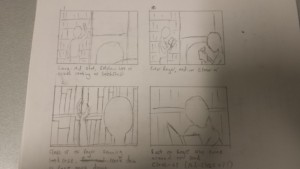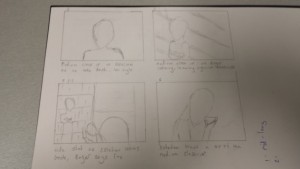I recently watched the Iranian-vampire-western film A Girl Walks Home Alone at Night, the feature debut of director Ana Lily Amirpour , and was blown away and inspired. The film is a powerful yet simple story of a female vampire who lives in the fictional town of Bad City who meets and consequently falls in love with a boy. It is heavily stylised, in black and white, with an amazing soundtrack which drives the film. Indeed, Amirpour has directed a number of music videos which definitely comes across throughout the film. I found this interview from vice, who helped fun the film, fascinating and inspiring, so I made a few notes of inspiration and advice to take away:
Amirpour came up with the character when she tried on the costume which the vampire wears in the film. It was a traditional Iranian garb which an extra wore in a short film she made a few years prior. Amirpour speaks about how the costume made her feel like a badass, and that she immediately felt compelled to skateboard (which is incorporated into the film). This illustrates the unlikely places which inspiration can come from. It came from a feeling, which was then given a character, context, and finally a story.
Amirpour and Sheila Vand, the lead actress who plays the vampire, discuss how they new each other for 5 years before making this film. Later in the interview Amirpour says as an aside that she knew all the actors, though this is probably an exaggeration. The fact stands that Vand’s performance is confident and powerful, and this is perhaps a reflection of her commitment to Amirpour and consequently her commitment to the story and character. This made me reflect on how important it is to form strong relationships with actors. Many film-makers use the same actors over and over again, most likely because they know each others method and can communicate easily. This highlighted the importance of engaging with actors and remaining in contact with ones that I find particularly good and hard working which would consequently make the casting process much easier and the production process more inspiring and enjoyable.
The research and development process for this film was deep and precise. An example is that Amirpour had created a timeline, complete with significant events for the character of the vampire. According to Vand, she had stack upon stacks of DVD’s from which she gathered inspiration. It is also mentioned that Amirpour knew exactly what song would go with what scene prior to production (and possibly prior to the final draft). This reaffirmed the idea that research and development is crucial to the creating a script or film of quality and substance.
Very briefly, Amirpour states that she has 12 scripts that she has written, and was considering making a film the normal “shitty” way, that is by giving a script to a studio which would then make arrangements for casting etc. etc. Instead she asked herself, “What is cool? what do I love?” and wrote A Girl Walks Home Alone at Night, cast her friends and bypassed the “shitty” method by avoiding studios and working with a smaller budget. This illustrated that the means by which one can make a film are not set, and that there are other ways by which one can achieve their vision, potentially more effectively and generally better than the normal “shitty” way.
It is mentioned that a short was made first. This is exciting to me as my focus now is on making short films. Obviously I do not have the reputation or the money, let alone the experience, to make a feature film, so I find it gratifying to know that this film existed as a short first. I can use more short films as blueprints of inspiration for my future endeavours.
The crux of the film, is about what each character is going through and why. Characters have to be real people, each of them have a story. This is excellent advise for a writer AND director. Too often films introduce characters who serve no other purpose than to allow for exposition or to motivate an action, however we know very little about who the character is and way. All the characters in A Girl Walks Home Alone at Night have a purpose and motivation.
The interviewer later asks if Vand was finishing a sentence that Amirpour had started. And responds in the affirmative, in a way. Saying that it is the role of the actor to become the character, to give part of yourself to the character, a thing which the director cannot do FOR the actor.
Finally, A very basic, and corny, idea which comes out is that they argue that the best stories are always about love. It’s easy to shun this statement but it carries a lot of weight. What motivates us? generally its others more than events or circumstances. As a writer, this is important to keep in mind when developing plot and character. For a film maker it is important when constructing a shot, and directing your actors. To have an ultimately complicated story to be rooted on a singular abstract concept, it helps root the film and keeps it on track.


